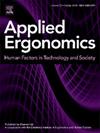Modeling anesthesia medication delivery using the SEIPS 101 tools
IF 3.1
2区 工程技术
Q2 ENGINEERING, INDUSTRIAL
引用次数: 0
Abstract
Background
Reducing the risk of patient harm during anesthesia medication administration in perioperative settings has been a long-term goal in patient safety. SEIPS 101 tools, provide a series of practice-orientated techniques to apply systems model in real clinical practice, potentially offering a straightforward approach to mapping perioperative medication delivery systems. Data was collected during direct observations of thirty-eight anesthetics, totaling over 100 h on anesthesia providers’ common tasks and interactions with people, environments, tools, and technologies. Observation data, notes, interviews, and literature were organized to create six SEIPS 101 tools demonstrating the complexity of anesthesia medication delivery. The Anesthesia PETT Scan represents the facilitators and barriers associated with differences in individual expertise, preferences, and potential conflict between providers. The People Map demonstrates the wide range of relevant individuals in medication delivery. The Task x Tools Matrix depicts the broad range of interconnected processes to provide anesthesia. The Journey Map describes the path used to deliver a medication. The Anesthesia Work System Interactions Map identifies necessary interactions that providers have with tools, tasks, people, and environment for successful anesthetics. The Outcome Matrix describes various stakeholder experiences and outcomes that contribute to overall system complexity. Identifying and describing the complexity in the anesthesia care delivery system is critical for effective and efficient process-centric interventions. This systems analysis may increase awareness to the limitations of current approaches and improve upon methods and interventions for understanding errors, safety, and the nature of clinical expertise and decision making.
使用SEIPS 101工具模拟麻醉给药
背景:降低围手术期麻醉给药过程中患者伤害的风险一直是患者安全的长期目标。SEIPS 101工具提供了一系列以实践为导向的技术,将系统模型应用于实际的临床实践,有可能为绘制围手术期给药系统提供一种直接的方法。数据是在对38种麻醉药的直接观察中收集的,总共超过100小时,关于麻醉提供者的共同任务以及与人、环境、工具和技术的互动。对观察数据、笔记、访谈和文献进行整理,创建了6个SEIPS 101工具,展示了麻醉给药的复杂性。麻醉PETT扫描代表了与个人专业知识、偏好和提供者之间潜在冲突差异相关的促进因素和障碍。人群地图显示了药物递送中相关个人的广泛范围。任务x工具矩阵描述了提供麻醉的广泛的相互关联的过程。旅程地图描述了运送药物的路径。麻醉工作系统交互图确定了成功麻醉的提供者与工具、任务、人员和环境之间的必要交互。结果矩阵描述了各种涉众的经验和对整个系统复杂性有贡献的结果。识别和描述麻醉护理交付系统的复杂性对于有效和高效的以过程为中心的干预至关重要。这种系统分析可以提高对当前方法局限性的认识,并改进方法和干预措施,以理解错误、安全性以及临床专业知识和决策的性质。
本文章由计算机程序翻译,如有差异,请以英文原文为准。
求助全文
约1分钟内获得全文
求助全文
来源期刊

Applied Ergonomics
工程技术-工程:工业
CiteScore
7.50
自引率
9.40%
发文量
248
审稿时长
53 days
期刊介绍:
Applied Ergonomics is aimed at ergonomists and all those interested in applying ergonomics/human factors in the design, planning and management of technical and social systems at work or leisure. Readership is truly international with subscribers in over 50 countries. Professionals for whom Applied Ergonomics is of interest include: ergonomists, designers, industrial engineers, health and safety specialists, systems engineers, design engineers, organizational psychologists, occupational health specialists and human-computer interaction specialists.
 求助内容:
求助内容: 应助结果提醒方式:
应助结果提醒方式:


